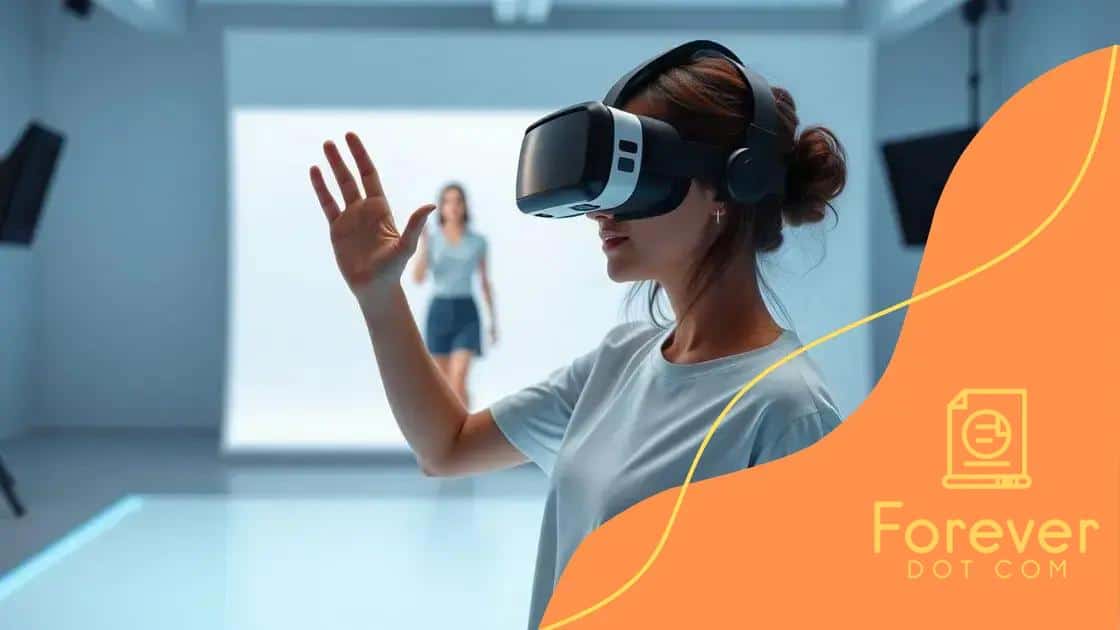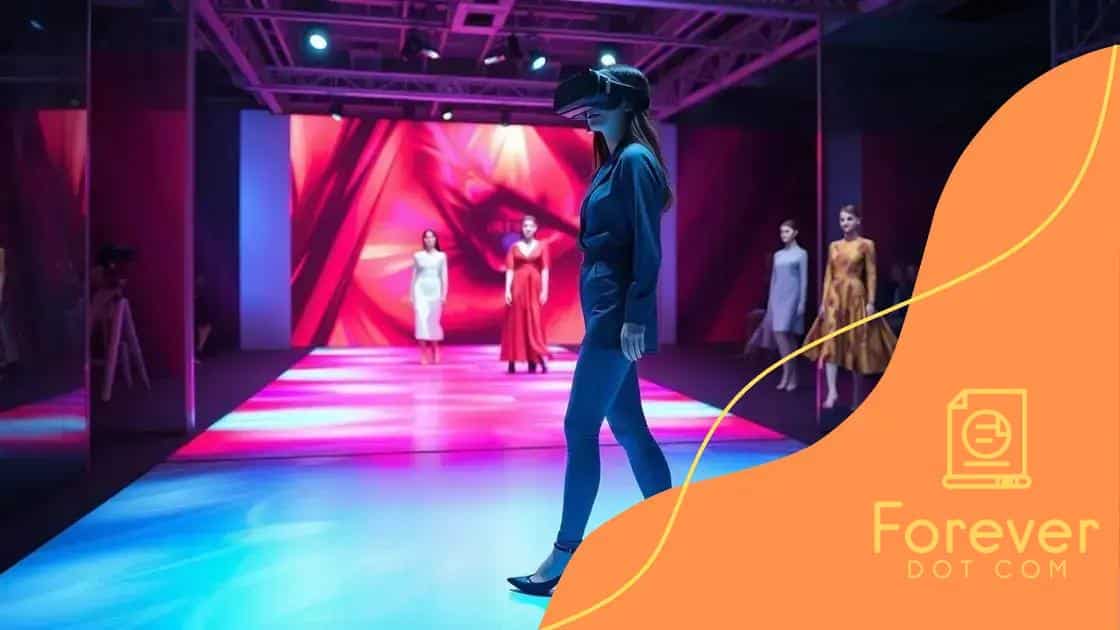Virtual reality training for aspiring models

Virtual reality training for aspiring models enhances skills and builds confidence by providing realistic practice environments, immediate feedback, and customized programs to meet individual needs.
Virtual reality training for aspiring models is changing the way newcomers to the fashion world prepare for their careers. Imagine stepping onto a digital runway, perfecting your poses and expressions with real-time feedback. This blend of technology and creativity invites exploration and growth in a competitive industry.
Understanding virtual reality in modeling
Understanding how virtual reality fits into modeling is crucial for the new generation of aspiring models. This technology offers a chance to practice in environments that simulate real-life scenarios. By using VR, models can refine their skills without the pressure of an actual runway.
What is Virtual Reality?
Virtual reality (VR) is a simulated experience that can be similar to or completely different from the real world. It typically involves the use of special equipment like VR headsets that allow models to immerse themselves in a digital environment. These virtual spaces can be designed to look like runways, photoshoots, or even fashion shows.
How VR Enhances Learning
Incorporating VR in training provides numerous benefits. Here are some of the key enhancements:
- Allows for repeated practice in a risk-free environment.
- Gives immediate feedback on poses and movements.
- Increases confidence by familiarizing models with different scenarios.
- Helps develop creativity in styling and presentation.
As models engage with VR, they can encounter various challenges that they might face in real life. For instance, they can practice walking in different types of shoes or responding to unexpected situations like a sudden change in lighting. These experiences prepare them for live events and improve their adaptability.
Moreover, VR training can be tailored to each model’s unique style and needs. This customization makes it a valuable tool for building a successful career in today’s competitive modeling industry. By embracing technology, aspiring models can enhance their skill set significantly.
Benefits of VR training for models
The benefits of VR training for models are numerous and impactful. This innovative technology provides a unique way to prepare for the fast-paced world of modeling. By immersing themselves in digital environments, aspiring models can practice their skills effectively.
Key Advantages of VR Training
VR training offers specific advantages that support the development of models. Here are some notable benefits:
- Enhanced Skill Development: Models can refine poses, expressions, and techniques in a realistic setting.
- Immediate Feedback: Real-time assessments allow models to adjust their performances quickly and improve continuously.
- Confidence Building: Practicing in a virtual space reduces anxiety while preparing for real-life situations.
- Cost Efficiency: Virtual training can save on travel and venue expenses while providing diverse experiences.
By utilizing VR technology, models can prepare for various scenarios, from fashion shows to photoshoots. This flexibility equips them with the tools needed for success. Imagine walking down a runway where the lights flicker and the crowd cheers.
Another benefit of VR training is the safe space it creates for experimentation. Models can try new styles and looks without the fear of judgment, fostering creativity. This approach encourages them to step outside their comfort zones, ultimately enhancing their versatility.
Moreover, the engaging nature of VR keeps training sessions interesting. Models are motivated to participate actively, leading to better retention of techniques and skills. The immersive experience allows them to connect emotionally with their training, making each session unique.
How VR enhances skills and builds confidence

Understanding how VR enhances skills and builds confidence is important for aspiring models. This technology allows individuals to engage in their training in a way that feels safe and effective. The immersive nature of virtual reality creates a space where models can practice without the pressure of a live audience.
Skill Enhancement Through VR Training
One of the primary benefits of using virtual reality is that it enables models to develop essential skills needed in their careers. For instance, models can practice walking, posing, and even interacting with an imaginary audience. These exercises help them become more comfortable and proficient in their craft.
Building Confidence in a Risk-Free Environment
Confidence is key in the modeling industry. VR training offers a unique platform where models can rehearse their routines repeatedly without fear of making mistakes. They can learn from their errors, adjust their techniques, and try out different looks. This freedom to explore without judgment encourages growth.
- Immersion: VR creates a lifelike experience, making practice sessions more engaging.
- Real-Time Feedback: Models receive instant evaluations on their performance, allowing for quick corrections.
- Variety of Scenarios: From runways to photoshoots, VR environments can simulate a range of experiences.
- Reduction of Performance Anxiety: Training in a virtual setting helps alleviate fears associated with public performance.
As models continue to use VR technology, they start to feel more at ease in real-world situations. This boost in confidence can lead to better performances during auditions and shows. They become more adept at handling the various pressures that come with the job.
The ability to practice specific reactions and movements in different contexts is also crucial. For example, adapting to different lighting conditions or audience reactions enhances their versatility. The blend of skill-building and confidence nurturing prepares aspiring models for the challenges of the industry, making them more marketable and successful over time.
Finding the right VR training programs
Finding the right VR training programs for aspiring models is essential for maximizing the benefits of this innovative technology. With so many options available, it is important to choose a program that suits individual learning styles and career goals.
Factors to Consider When Choosing a Program
When selecting a VR training program, aspiring models should keep in mind several key factors. These include:
- Content Relevance: The program should focus on skills and techniques specific to modeling.
- User Feedback: Look for reviews and testimonials from other models who have used the program.
- Technological Quality: Ensure the VR experience is engaging and uses high-quality visuals and sound.
- Support and Resources: A good program should provide access to mentors or additional learning materials.
Another important aspect is the flexibility of the training schedule. Many aspiring models have busy lives, so a program that offers on-demand access to training can be very attractive. This means models can practice whenever they have free time, accommodating their unique schedules.
Exploring various platforms that offer VR training is also beneficial. Some are more comprehensive, while others may focus on specific areas within modeling. For example, some programs might specialize in runway techniques, while others could emphasize posing for photoshoots.
Additionally, aspiring models should consider programs that allow for customization of their training. Personalized experiences enable models to work on their weaknesses and develop their strengths effectively.
Real success stories of models using VR
Real success stories of models using VR technology demonstrate how this innovative training method can transform careers. Many aspiring models have shared their experiences, highlighting the advantages and progress they made through virtual reality training.
Case Study: Rachel’s Journey
Rachel, a young model, struggled with her confidence when walking down the runway. After starting VR training, she experienced a significant change. The program allowed her to practice in various virtual environments that simulated live shows. This practice helped her master her walk and poses effectively.
Jonas’s Transformation
Another inspiring story is that of Jonas, who wanted to enhance his posing skills for photoshoots. Using a VR program tailored for photographers’ feedback, he learned how to position himself more effectively in front of the camera. He found that he could visualize his movements clearly, leading to better results in real-photo sessions.
Improvement Through Feedback
These models have noted that the immediate feedback offered in VR training is invaluable. They could instantly see their performances and make adjustments on the spot. This level of interaction is something they could only dream about in traditional training settings.
- Enhanced Skills: Users report noticeable improvements in their posing and walking abilities.
- Greater Confidence: Many models feel more prepared for live situations after their VR sessions.
- Stronger Imagination: The immersion helps models visualize their performance in different scenarios.
- Building Relationships: Some VR programs allow collaborations with other models, fostering community and teamwork.
The stories of Rachel, Jonas, and others reflect the potential of VR technology in the modeling industry. As more individuals embrace this innovative approach, the possibilities for growth and success continue to expand.
In summary, virtual reality training offers aspiring models an innovative way to enhance their skills and boost their confidence. With VR, they can practice in realistic environments and receive instant feedback, making their learning process both effective and engaging. As success stories show, this technology is truly changing the landscape for models, paving the way for new opportunities in the industry. Embracing VR not only prepares them for the challenges of modeling but also opens up exciting possibilities for their futures.
FAQ – Frequently Asked Questions about Virtual Reality Training for Models
How does VR training help improve modeling skills?
VR training allows models to practice in realistic environments, enhancing their posing and walking techniques through immersive experiences.
Can VR training boost a model’s confidence?
Yes, by providing a risk-free space to rehearse, models can build their confidence as they perfect their skills without the pressure of a live audience.
What types of feedback do models receive during VR training?
Models get immediate feedback on their performances, helping them to make adjustments quickly, which accelerates their learning process.
Are there customizable VR training programs available?
Absolutely! Many VR training programs offer customization to suit individual learning styles, allowing models to focus on their specific needs.






